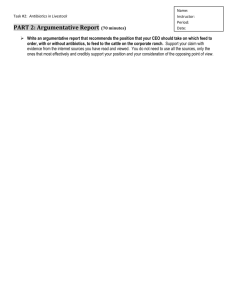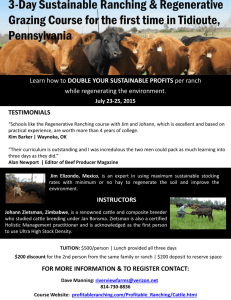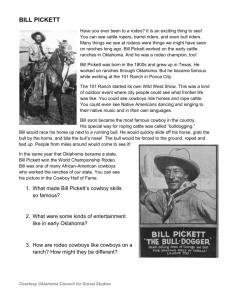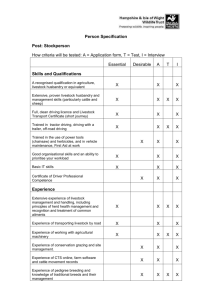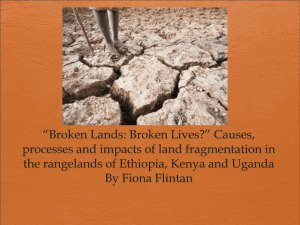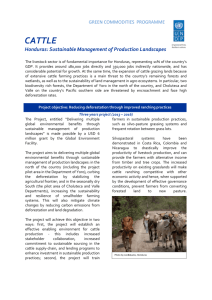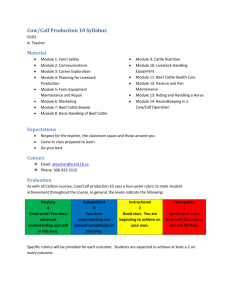Cow – calf camps - Natural Resources Institute
advertisement
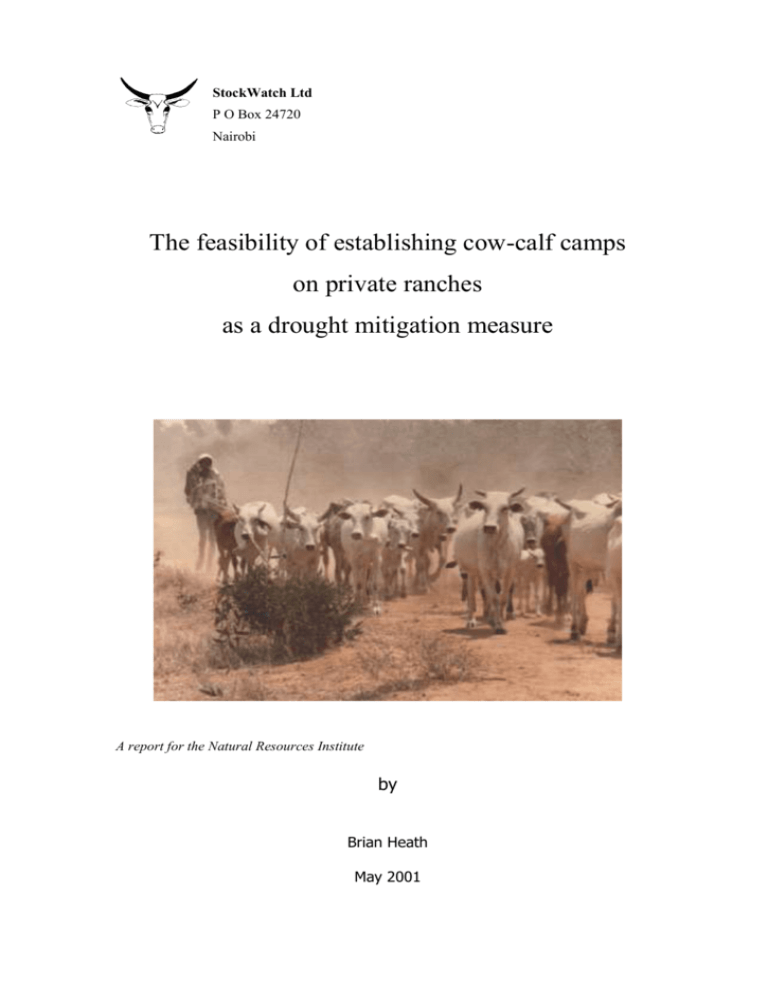
StockWatch Ltd P O Box 24720 Nairobi The feasibility of establishing cow-calf camps on private ranches as a drought mitigation measure A report for the Natural Resources Institute by Brian Heath May 2001 TABLE OF CONTENTS SUMMARY ................................................................................................................................. 3 BACKGROUND .......................................................................................................................... 3 THE PASTORAL LAND OF KENYA .............................................................................................. 4 THE PASTORALIST SECTOR ....................................................................................................... 5 THE RANCHING SECTOR ............................................................................................................ 6 THE CONCEPT OF COW-CALF CAMPS......................................................................................... 7 There were a number of lessons from this exercise:............................................................. 8 OPTIONS AVAILABLE ................................................................................................................ 9 Utilise grazing in National Parks during droughts. ............................................................. 9 Develop long-term contracts with existing ranches, whereby the ranch owners allow a limited number of livestock to graze on their land. .............................................................. 9 Purchase or take over an existing ranch for the specific purpose of protecting valuable pastoralist breeding stock..................................................................................................... 9 CONCLUSION .......................................................................................................................... 11 BIBLIOGRAPHY ....................................................................................................................... 12 Cow-calf camps 2 Summary Kenya’s population has increased fourfold since independence in 1963. This factor, together with five droughts in 20 years, has led to decreased productivity of the rangelands and a significant reduction in the cattle population. The result has been increased destitution and an increased reliance on relief for those that have fallen out of the pastoral system. Pastoral area land tenure systems have exacerbated the effect of drought by excising valuable rangeland for National Parks and game reserves or private and group ranches. There is increasing pressure to provide individual title on group ranches, particularly in those areas with agricultural potential. This is further fragmenting land and increasing conflict between pastoralists and agriculturalists. In those areas that have not been excised, the Trust Lands, competition for resources leads to conflict and insecurity, depriving pastoralists access to productive areas. These factors have led to increased pressure on existing ranches and private land. The drought in 2000 forced many of the pastoralists onto private land and protected areas. After an initial problem, selected pastoral livestock owners were allowed to keep up to 200 cattle on each of the ranches in Laikipia for the duration of the drought. However, there is no support from most of the ranches for any long-term grazing arrangements. The ranches are no longer able to make a profit from cattle and the majority have either closed down, diversified into irrigated horticulture, where possible, limited agriculture or been sold off to wealthy foreigners. There are a number of options for a trial community owned ranch in Laikipia, one such government owned ranch has been overrun by the Samburu. The Samburu have recently supported the preparation of a management plan for the ranch that would limit the number of livestock and work towards a sustainable livestock and wildlife venture. This would be a perfect opportunity for the Samburu to use the area to protect their most valuable breeding animals. If the government were to insist on payment for the land, the whole venture together with infrastructure improvements would cost in the region of £2.2 million. One other ranch, currently for sale, would cost £5 million, it is the best ranch in the country but no private investors are prepared to buy it and the price has been reduced by 50% in two years. Background Kenya’s population has quadrupled, from 8 to 30 million in the past forty years and the rate of increase has been no lower in the pastoral areas than elsewhere, indeed the population of North-Eastern Province grew by an annual rate of 9.25% between 1989 and 1999, trebling the population from 300,000 to 900,000 in just ten years. These massive population increases have not been matched by increases in infrastructure, available resources or livestock and the average pastoralist is now much poorer than they were thirty years ago. Until the late 1960’s and early 1970’s livestock numbers were able to keep pace with the increased human population but cattle numbers peaked and by the mid-1970s grazing areas became overstocked and for the first time there were signs of serious environmental degradation. This was particularly apparent in areas with relatively high rainfall (700 mm/annum) and well-drained red lateritic soils such as Baringo, the pastoral areas of Laikipia and Samburu Districts. Cattle owners intensified their diversification into smallstock and these sheep and goats proceeded to compound the land degradation. There have been seven major droughts on the African continent in the last four decades: 1965/66, 1972/74, 1981/84, 1986/87, 1991/92, 1994/95 and 1999/2001. The 1981/84 drought was the worst ever recorded for the Greater Horn of Africa (GHA). The exceptional El Niño rains in 1997/8 brought its own problems and every year in the 1990’s, bar 1995, was Cow-calf camps 3 considered a disaster in the North Eastern Province of Kenya. The drought in 1999/01 was considered to be on a par with the 1984 drought but early warning systems funded by USAID (Famine Early Warning System – FEWS) and the World Bank (Arid Lands Resource Management Project – ALRMP) enabled a timely and efficient response in providing food relief to the affected districts. The World Food Programme was able to mobilise considerable resources and move thousands of tons of food, worth over US$ 239 million, to the drought stricken areas. In the past year Kenya has become the third largest recipient of emergency food relief after North Korea and Ethiopia. During 2000 an emergency fund was also established for non-food interventions by the European Union (EU). Dozens of water, emergency off-take and veterinary interventions have been carried out in the pastoral areas of northern Kenya by Non-Governmental Organisations (NGOs) operating in the region (Appendix 1). These interventions have no doubt reduced the livestock mortality in the short term but have done little to address the underlying problem of too many people depending on too few resources. In fact it can be argued that many of the emergency interventions destroy long-term efforts at making the pastoralists self-reliant. This report looks at the arid and semi-arid areas of northern and south-eastern Kenya and investigates one option for protecting valuable pastoralist breeding stock in future droughts, through establishing cow-calf herds with pastoralists. The pastoral land of Kenya Virtually all of Kenya’s rangelands are classified as Trust Lands that are entrusted the local County Councils through the Trust Land Act Cap 290 of 1941 that vests Radical Title until such time as the land can be adjudicated (Figure 1). The owners of this land are the traditional users and Customary Law is supposed to prevail until such time as the land is adjudicated and registered. One land rights option available to customary users has been to register land for a group ranch, such land must be adjudicated under the Land Adjudication Act Ch 284 (1967 and 1972) and once a series of requirements are fulfilled a group of customary users are granted Title to a defined piece of land. Group ranches were formed in the more productive areas, with some potential for agriculture or wildlife tourism. This has happened in Laikipia, Samburu, Narok, Trans Mara and Kajiado Districts but group ranches have not proved the answer and in fact there are considerable pressures for individual ownership by registered group members. This has led to sub-division of group ranch land and the issuance of individual Titles. In theory such sub-divided areas must be able to sustain a family and the minimum size should be 40 – 50 hectares and able to support four Tropical Livestock Units. However, since the original registration of these group ranches there has been a three or four fold increase in the membership and land is being divided into unviable units. The pressure to sub-divide is greatest in areas with agricultural potential and this has led to a patchwork of small farms being purchased from the individual owners by agriculturalists. This not only causes conflict between the farmer and pastoralists but also denies access to some of the pastoralists’ most important dry season grazing. The Kenya Government, through the Crown Lands Ordinance of 1904, was able to alienate under-utilised land, and large tracts of pastoral grazing land were excised in the late 1940’s and 1950’s to form National Parks and National Reserves. The National Parks were often in important grazing areas for the pastoralists and their formation immediately denied access to thousands of square miles of grazing land. Further alienation of key dry season grazing areas for agriculture and irrigation has further reduced land available to pastoralists. Most Trust Land remains under the jurisdiction of the County Councils and although it is supposed to be held on behalf of the customary users the official policy in Kenya is not to restrict movement. This leads to the more aggressive pastoralist groups moving into areas traditionally occupied by smaller or weaker tribes or clans. This factor alone is one of the Cow-calf camps 4 underlying features behind increased tribal conflict and insecurity in pastoral areas and this problem will not be resolved until the basic land tenure system in pastoral areas is addressed. The government is aware of the problems relating to common resource use and its role in fuelling conflict but there are still vested interests in retaining the status quo. This is particularly true of certain clans in North-Eastern Province who, with an annual increase of over 9%, require land to support the added population. There are many people who would challenge the official increase recorded between the last two censuses but there is no doubt that there has been migration into Kenya from Somalia and there are no indications that the people will return once the situation improves in Somalia. Most traditional pastoral systems had some form of “private” control over water resources, many of the wells were owned by individual families or clans. Under the traditional system, water resources, and thus grazing areas, were often managed by the elders and traditional councils. The construction of public boreholes led to a proliferation of government administrative centres and all but destroyed the traditional management systems. The majority of donor organisations and NGOs operating in pastoralist areas are trying to revive some form of management system over boreholes and are promoting the formation of water and natural resource user associations as a means of controlling water and thus rangeland use. The water user associations are plagued by problems of accountability and management and are still a long way off from fulfilling their role as custodians of the natural resources within their areas. In time these associations may play an important role but at present the continued emergency interventions tend to undermine efforts at longer-term sustainable management of resources. The pastoralist sector As already explained, the human population has expanded fourfold in pastoral areas within the past forty years. Livestock populations, and in particular cattle populations have either remained static or declined. The International Livestock Research Institute (ILRI) has recorded drought mortality rates of 35.2% for cattle in northern Kenya, with up to 63% of the calves dying. When droughts occur every eight to ten years the livestock populations have a chance to recover. However, the frequency of droughts has increased in the past twenty years, with five recorded droughts between 1981/2001. Aerial counts undertaken between 1977 and 1994 by the Department of Resource Surveys and Remote Sensing (DRSRS) within the Ministry of Planning show a declining trend in cattle numbers in the arid districts of Rift Valley (74%), Eastern (44%) and North-Eastern (30%) provinces. Smallstock have taken over as the most important livestock species in the more arid areas of northern Kenya and a survey conducted by ILRI indicated an average herd size of 78 smallstock per household. The mortality rates for smallstock tend to be similar, or even slightly higher, than for cattle in droughts, with mortality rates of 43% compared to 35% but their advantage is that populations are able to recover quickly post drought. Camels are better able to cope with droughts, with an estimated mortality rate of 18% and populations have essentially remained the same over the past thirty years. Camels are now accepted by traditional cattle keeping pastoralists in Moyale and Samburu districts and have even been introduced into the drier parts of Kajiado District. The overall impact of the decline in cattle populations is that fewer pastoralist families are able to rely on their livestock as a sole means of support. In each drought more people fall out of the pastoral system and join the ranks of the peri-urban poor, a significant feature around all towns and villages in northern Kenya. These pastoral system drop-outs never want to return to pastoralism and become wholly reliant on donor support and food-aid. With little or no education and few opportunities to find or create employment the majority of peri-urban poor will undoubtedly require support for generations to come. Some of the people in and around Cow-calf camps 5 the villages have become reasonably wealthy and they invest in livestock, which are then herded by paid herdsmen under the traditional system. The increase in urban centres and resultant environmental degradation around permanent settlements and water points has heightened the impact of drought and now a “normal” year does not provide sufficient moisture in the soil to promote significant grass growth. It has been estimated that pasture levels have been reduced from 3 tonnes/ha to 0.5 t/ha in parts of Laikipia within the past ten years. The levels of gully and sheet erosion in the same region are now so severe that up to 500 tonnes of top-soil are lost per hectare annually. The result of this degradation is that sustainable stocking rates have declined from 1 TLU/15 ha to 1TLU/50-100 ha in areas with an annual rainfall of between 500 - 700 mm. The degradation of land and increased human populations has inevitably led to increasing pressure by the pastoralists on adjoining adjudicated private and public land. This culminated in the invasion of private ranches and forest land by the pastoralists in May 2000. The ranches were themselves experiencing severe drought and in many instances were having to provide supplementary feed to their livestock in order that it survived. The majority of land owners resisted the invasions but there were a few people who sympathised with the pastoralists and offered to help by allowing a limited number of cattle to graze their land in what were effectively cow-calf camps. The ranching sector The majority of commercial ranches were established in the early 1900’s as a buffer between pastoralist and agricultural tribes. They were all granted 99 year leases and many of these leases are due for renewal by 2010. In Laikipia there is pressure by the local Maasai, who claim to be the traditional owners of the land to have the ranches revert to them on expiry of the current leases. During the 1960’s and early 1970’s the government promoted the formation of private and group ranches the Coast Province and a number of private co-operative ranches were established in Tana River, Kilifi, Kwale and Taita/Taveta Districts (Figure 2 and 3). They were supported by World Bank funded soft loans through the Agricultural Finance Corporation and purchased their cattle through a well established livestock marketing system run by the Ministry of Agriculture. By the late 1970s the Livestock Marketing Division in the Ministry had all but collapsed, as had the system of testing and quarantining cattle for Contagious Bovine Pleuro-Pneumonia (CBPP). This led to the market in immature pastoralist cattle drying up and the collapse of most of these ranches, by 1990 the last of the functioning ranches was acquired by the government and by 1995 there was not one fully functioning ranch in coast province and the majority had extensive debts with the AFC. Laikipia is still the most important private ranching region in the country but at least 30% of the ranch land in the district has been purchased by land-buying companies with the express purpose of sub-division for agriculture since the 1970’s (Figure 4). The remaining ranches were able to make a reasonable living until the late 1980’s, when the cost of inputs became so expensive that ranchers found themselves de-stocking in order to meet recurrent expenditure. The collapse of both the Kenya Meat Commission and an export market for live cattle to the Middle East depressed the livestock industry and the price of beef was further reduced; ranching became unviable. A series of papers on the economics of ranching in Kenya between 1995 and 1997 all concluded that livestock ranching offered very poor financial returns (0.2 – 1.4 US$/ha). Most of the remaining ranches were either, advertised for sale and purchased by investors who were not interested in financial gain or, the owners diversified into wildlife tourism (returns of 4.4 – 4.7 US$/ha) or irrigated agriculture (returns 132 – 166 US$/ha). Two ranches in Laikipia were handed over to the Ministry of Lands and Settlement for sub-division and were immediately overrun by Pokot and Samburu pastoralists. Cow-calf camps 6 During the same period a number of private ranches in Machakos district were sold to local cooperatives, part of these ranches were sub-divided and land given to the new owners but on the whole they retained the majority of land for ranching. A few ranches were sold in the Rift Valley, some were sub-divided and others became an extension to the Maasai grazing lands. There are two large-scale ranches remaining in the Rift Valley and both rely on tourism or agriculture to meet their financial obligations. The concept of cow-calf camps Pastoralists have practised a nomadic lifestyle for generations on the premise that this offered the best and most sustainable form of land use in ASAL areas. Nomadic pastoralism has never had the full support of governments as the nomads are seen to be ungovernable and beyond the reach of basic services. During the 1970’s there was a concerted effort by the Kenya Government to settle pastoralists “so that they could have better access to water, health and education facilities”. This resulted in the sedenterisation of a number of pastoral groups, most noticeably the Samburu and Rendille of northern Kenya and the Maasai in southern Kenya. This policy of settling the pastoralist is no longer in vogue and livestock continues to be highly mobile in the arid parts of the country. The difference is that the animals are looked after by the young men and women in “Fora” camps; while the parents and an increasing number of absentee owners remain within close proximity of the centres – with a few milk animals. These valuable milk animals become very susceptible to the effects of drought as they remain in areas already overgrazed and degraded. One of the first coping strategies for pastoralists in a drought is to increase the distance livestock trek to water. This increases from an average of 5.9 km pre-drought to 15.8 kms during the drought. The ability to move animals away from water sources and increase the drinking interval to three days, coupled with the ability to be highly mobile still offers pastoralists the best drought coping strategy and a recent survey of northern Kenya by the author confirmed the importance of mobility to the pastoralists. Despite the fact that the current drought is one of the worst on record the pastoralists in Marsabit, Mandera and Wajir have managed to lose surprisingly few animals; the majority have been moved into Ethiopia, Somalia and southern Garissa. This strategy is fine for pastoralist groups that can cross national boundaries or have huge areas to cover. It is no longer applicable to those ethnic groups who have been squeezed into small, reasonably well-defined areas. The concept of controlling grazing as a means of protecting valuable breeding animals in times of drought is not new to development agencies and the government. Various schemes have been tried from a grazing blocks scheme in North-Eastern Province and group ranches in the Maasai and Samburu Grazing areas to the co-operative ranches established in Coast Province. All the schemes are defunct or have serious flaws and new ways need to be explored for protecting the most valuable animals in a pastoralist’s herd, for as long as there is an open access and communal system of livestock management with no checks and balances there will be a tendency to over utilise the available resources. In one area the Uaso Nyiro Boran relied on the traditional “deda” council to manage and control the use of a strategic grazing that had a borehole by removing the pumps and engines until such time as the elders decreed that the area should be opened for grazing. In one area of Isiolo District, Yamicha, the Catholic Church retained the engine until they were asked to install it by the council. Unfortunately, the Boran have now established a permanent settlement and this system seems to have broken down in recent years. The precedent for grazing a limited number of cattle on behalf of pastoralists has been set and one ranch in Machakos, Game Ranching Ltd, has grazed livestock on behalf of local livestock owners and charges a monthly grazing fee of approximately £2 per head/month. The invasion Cow-calf camps 7 of private ranches in Laikipia forced the owners to consider various means of helping the pastoralists, including grazing a limited number of animals on each ranch. In May 2000, after a series of meetings it was agreed that the private ranches would each accept 200 head of valuable breeding animals for the duration of the drought. This catered for less than 2,000 cattle, mainly belonging to rich and influential owners, rather than the pastoralists. At the same time the government allowed livestock into the Mount Kenya Forest Reserve and thousands of head migrated into the forests from the group ranches in Samburu and Laikipia. The change in vegetation, climate and disease challenge all contributed to a very high death rate and it was estimated that up to 60% of the cattle in some herds died in the forest, forcing many of the pastoralists to return to the lowlands. The ranchers had a vested interest in keeping the pastoralists off the ranches and they clubbed together to purchase relief food, veterinary drugs and accaricides for the people on the mountain. They also rehabilitated a number of cattle dips and crushes. Within weeks the ranchers had raised approximately £90,000. There were a number of lessons from this exercise: Those pastoralists that can no longer move their animals over huge distances in search of food and water were forced to seek pasture on private of forest reserve land. The uncontrolled movement of livestock greatly increases the risk from disease. Animals that came up from the lowlands were exposed to diseases such as East Coast Fever and suffered significant losses. They in turn infected ranch cattle with Foot and Mouth Disease and in one case suspected CBPP. Group ranches were as heavily grazed as Trust Land and afforded no protection to the pastoralists in times of drought. Those ranchers that had developed a long-term relationship with their neighbours and had assisted them in developing tourism and wildlife projects or with community development initiatives did not experience the same invasion as ranchers with an island mentality. Those ranchers that did not look beyond their borders and had a poor relationship with their neighbouring communities experienced aggressive walk-ons and for a while there was considerable tension. One ranch allowed a limited number of cattle on the property and was invaded by over 15,000 head. Their subsequent eviction caused a political storm and the landowner is now being sued for the loss of 13,000 animals, which the pastoralists said died as a result of the eviction. Some of the ranches were suffering from the drought and losing livestock themselves were very reluctant to support additional cattle. Ranches that had cut and stored surplus grass after El Niño were able to keep their animals alive throughout the drought by supplementing their feed with hay and molasses. However, the cost of hay increased six-fold and became prohibitive for those that had not stored for the drought. Ranches can support a limited number of pastoralist livestock from neighbouring pastoralist areas for the duration of a drought but the majority are struggling financially and are not interested in the added burden of looking after other people’s cattle. Ranchers are also concerned about the long-term implications of allowing pastoralist stock onto their properties and feel that allowing them on once forms a toehold for the pastoralists onto their land. Cow-calf camps 8 Options available Utilise grazing in National Parks during droughts. The larger National Parks, such as Tsavo, are invariably invaded during times of drought, the subsequent eviction invariably causes tension and heightens resentment by the pastoralists for lost land. It could be argued that pastoralists and their livestock are part of the natural environment and that the exclusion of all livestock from National Parks could be detrimental to conservation – there are certainly more animals outside the Maasai Mara Game Reserve than inside. Controlled numbers of cattle could be kept in certain areas of a park such as Tsavo, the pastoralists should be made to pay a grazing fee for the right to keep their animals. This option is raised but not taken any further in this paper. Develop long-term contracts with existing ranches, whereby the ranch owners allow a limited number of livestock to graze on their land. This is not seen as a viable long-term solution. However, within Laikipia there are five ranches that would allow a limited number of animals to graze their land in return for grazing fees of approximately £2 head/month. This would cater for approximately 1,500 head of breeding stock. In times of serious drought a further five ranches might accept cattle on a short-term basis but would not allow any long-term presence. In Machakos there is one ranch that allows long-term grazing for a fee. This might support up to 500 breeding cattle. Purchase or take over an existing ranch for the specific purpose of protecting valuable pastoralist breeding stock. The privatisation of pastoral land has not proved the solution in the past as it tends to benefit the elite at the expense of the poorer pastoralists. Any proposal that advocates runs the inherent risk that the same would be true. However, there are three government owned ranches in Laikipia that have potential as a base for cow-calf herds. Such ranches would be suitable for settlement and management by local Samburu, Pokot and Maasai pastoralists, who already claim the land, but would not be suitable for pastoralist from outside the region as it would surely lead to conflict. One of these ranches, P&D, known by the Samburu as “Ilpinguan”, is 54,000 acres (22,000 ha) and the Samburu have already supported the concept of an organised management plan for the property. This ranch was purchased by the government in 1992 for settlement and immediately overrun by the Samburu, who have looted the infrastructure and caused considerable environmental degradation in just nine years. The Samburu appreciate the fact that they have a traditional, but no legal, right to the land and their leadership has proposed that they approach the government with a sensible management plan that would grant them the right to use the land. This management plan was developed together with the local stakeholders and funded by private ranchers and the Dutch funded Arid and Semi-arid Lands project in Laikipia and will be presented to the government as a model for sustainable management of communal land. P&D will serve as the model, but the other two ranches are similar and the same costs and principles could apply. The proposal developed and accepted by the Samburu is for 400 families already settled on the ranch to become shareholders in a private company. The owners would engage professional management to run the ranch. Cow-calf camps 9 The owners will then reduce the livestock population on the ranch from the current level, about 15,000 head of cattle, and 45,000 sheep and goats by 90% for a period of two to three years in order that the land has time to recover. The current proposal is that the remaining stock will be slaughter stock for fattening but there is no reason why the animals could not be breeding stock. 10,000 acres will be retained for livestock development and the remainder will be set aside as a conservation area for wildlife. In time the grass from this conservation area could be cut and stored as hay for droughts. Cost of rehabilitating the ranch For the purposes of this exercise it is assumed that the new owners of such a ranch would have to purchase the land and re-develop the infrastructure before it could become operational. Ranch land in Laikipia is valued at US$140 (£100) per hectare for improved land. For the purposes of this exercise it is assumed that this is the price that would be paid for land and the rehabilitation of existing structures. In the event that the land is granted to the community the cost of rehabilitation would be in the region of £20 per hectare or £440,000 for the whole ranch. Any land with agricultural potential immediately increases tenfold in value. Cost of purchasing a community ranch Capital Size Improved land Vehicles Total Value/unit (£) Total value (£) 22,000 100 2,200,000 2 30,000 60,000 2,260,000 It is assumed that the ranch could support 2,000 cattle of which 1,440 would be breeding stock and their replacements and the remainder would be fattening stock. In this scenario 400 cattle could be sold annually to cover management and direct costs. Estimated cash flow from such a ranch in £ Sterling Income Cattle sales 400 Expenditure Direct costs Labour Dip, salt and vet Overheads Management Labour Equipment/transport Fuel Water supply Office/bank etc TOTAL Profit av.wt 400 av.pr/kg 0.6 Total 96,000 Unit Cost/unit Total 40 12 360 720 14,400 8,640 1 25 12 12 12 12 15,000 485 2,200 600 360 600 15,000 12,125 26,400 7,200 4,320 7,200 95,285 715 There is one other privately owned ranch on the market at present, this particular ranch is over 30,000 ha in extent and is situated on some of the best ranching land in eastern Africa, with pockets of agricultural land. The asking price has come down from £10 million to £5 million over the past two years for a viable and operating ranch that has the capacity to carry over Cow-calf camps 10 10,000 head of cattle. This ranch already boasts one of the best Boran cattle herds anywhere and the animals are probably of too high a quality to re-stock pastoralist areas. The potential for cow-calf ranches in Coast Province As already explained the majority of ranches in Coast Province are defunct, two owned by the government, Galana and Kulalu ranches comprise an area of 700,000 hectares and one of them, Galana, adjoins the Orma grazing lands in Tana River. This ranch has been severely run down during the past ten years and the cattle numbers have dropped from 30,000 to less than 5,000 during that period. This ranch is no longer a economic entity and the Orma have invaded it from the North, using constructed dams and natural pans for their livestock. The Orma are based along the southern end of the Tana River and concentrate their animals in the delta during the dry season – they very seldom suffer the effects of drought and their major problems revolve around livestock diseases Trypanosomiasis and Helminthisiasis and insecurity as a result of encroachment by the Somali pastoralists to the North. Other ranches in Taita/Taveta could be rehabilitated but they do not border pastoralist areas and would offer no real opportunities as cow-calf ranches. A recent study on the commercial viability of ranches in Taita and Kwale concluded that they could break even with a herd of 12,000 animals. This is more than any but the largest ranch could support and it would take over 15 years to pay off the capital investment required to re-habilitate a ranch. Conclusion The fundamental problems facing pastoralists revolve around the very high rate of population increase and the corresponding over-exploitation of existing resources, coupled with an open access grazing system. Some private ranches are prepared to offer support towards retaining valuable pastoralist animals but the numbers that could be supported are minute in terms of the overall population. The government owns ranch land in Laikipia and these ranches would offer the best opportunity to experiment with pastoralists forming limited liability companies to manage this land on a sustainable basis for the benefit of it’s shareholders. The cost of reviving such a property would be in the region of £ 2 million, if the land is to be purchased and only £ 440,000 if the land was granted to the shareholders. The shareholders would then contribute their animals to the project and this would be sufficient to generate the income required to manage the property. Tourism and wildlife utilisation offer other chances to generate income for the benefit of the shareholders. Should the concept work, it could then be tried elsewhere. Cow-calf camps 11 Bibliography Awere-Gyekye, K. 1995. Land Use and Wildlife Conservation. A policy proposal for Land Use Planning and Co-ordination in Kenya. Kenya Wildlife Service. Coppock, D. L. 1994. The Borana Plateau of Southern Ethiopia: Synthesis of pastoral research, development and change, 1980-91. Elliott, J and Mwangi, M. 1997. Making Wildlife “Pay” in Laikipia, Kenya. African Wildlife Foundation. Grunblatt, J Said, M Wargute, P and Kifugo, S. 1995. DRSRS data summary report. Kenyan rangelands 1977-1994. Ministry of Planning and National Development. Nairobi Heath, B. 1996. Galana Ranch – a history. StockWatch Ltd. Nairobi. Heath, B. 2000. Ranching: an economic yardstick. In Wildlife Conservation by Sustainable Use. Ed. H Prins, J Grootenhuis and T Dolan. Kluwer Academic Publishers. Heath, B. 2000. Beef Ranching – is it a viable option. Report to Trident Consultants. Nairobi. Kituyi, M. 1998. Kenya. In Custodians of the Commons. Pastoral Land Tenure in East and West Africa. Ed. C R Lane. Earthscan. Mwau. G. 1995. Wildlife Utilisation Study – economic analysis. Kenya Wildlife Service and the African Wildlife Foundation. Mwichabe, S. Gitau, M. and Lekupe, D. 2000. Land tenure (and use) change scenario for improved productivity of the P&D Ranch. Rumuruti Division, Laikipia District. The Laikipia Wildlife Forum. Ndikumana, J. Stuth, J. Kamidi, R. Ossiya, S. Marambii, R. and Hamlett, P. 2000. Coping mechanisms and their efficacy in disaster-prone pastoral systems of the Greater Horn of Africa. Effects of the 1995-97 drought and the 1997-98 El Niño rains and the responses of pastoralists and livestock. ILRI project report, Nairobi. Sweet, J. 1998. Livestock – coping with drought: Namibia case study. Cow-calf camps 12 European Union emergency support for the 1999/2001 drought in Kenya Contract number and partner Programme activities and location Contract amount CDTF emergency drought programme – support from Stabex funds Contribution to WFP – EMOP 6203 Feb-June 2000 ECHO/KEN/210/2000/02001 – Action Against Hunger Human health, water, livestock, conflict resolution, emergency seed supply € 300,000,000 ECHO/KEN/210/2000/02002 – UNICEF ECHO/KEN/210/2000/02003 – VSF Switzerland Contribution to WFP – EMOP 6203.1 ECHO/KEN/210/2000/03001 – UNA/COOPI ECHO/KEN/210/2000/03002 – multiple recipients through CORDAID ECHO/KEN/210/2000/03003 – Action Against Hunger ECHO/KEN/210/2000/03004 – multiple recipients through CORDAID Emergency borehole regeneration, Moyale. 17/07/2000 – 16/03/2001. No cost extension until 15/05/2001 Supplementary feeding immunisation and health. Targeting under 5s, pregnant and nursing mothers. 01/08/2000 – 30/01/2001 Livestock health and off-take North Eastern Province. 01/08/2000 – 28/02/2001. No cost extension until 31/03/2001 25,000 m tons cereals, transport and delivery Livestock health and de-stocking support programme in Samburu, Marsabit and Moyale. 01/11/2000 – 30.04.2001. Extension requested CDTF – emergency drought programme – water and livestock support. 20/10/2000 – 20/10/2001 Emergency nutritional assistance for drought affected communities El Wak, Mandera District. 15/12/2000 – 14/06/2001 CDTF – emergency drought programme Ph II € 1,000,000 € 470,000 € 10,500,000 € 390,000 € 1,000,000 € 260,000 € 350,000 € 314,360,000 TOTAL Cow-calf camps € 390,000 13
